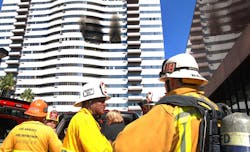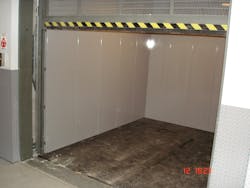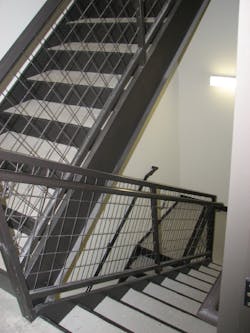High-Rise Buildings: What to Know Before You Go
As the number of challenges associated with high-rise buildings continue to increase, so too does the responsibility of the fire department to know as much as possible about these buildings’ design, construction and occupancy. Information is the key to effective, efficient and safe decision-making. Without it, efforts and resources will be misguided. So where do we start? We start with the basics.
Elevators
The elevator is referred to by many as a “necessary evil” in a high-rise building fire. Elevators are the only practical means of quickly moving many resources to the upper floors of the building. There is no doubt that their use has caused problems, the most notable being members becoming trapped in a stalled elevator car. It is for this reason that the use of elevators in a high-rise building fire must come with a strict set of operational guidelines. But prior to accessing an elevator and starting up, there must be an understanding of elevator type and design, bank and floor accessibility, as well as when and how to use them.
Freight/service elevators
New and recently installed freight elevators are different. They are required to have the same protection and design features as a passenger elevator. Consider the advantages: An oversized elevator car that is designed to handle additional weight with Phase 1 and 2 firefighter control features becomes an attractive option for the fire department. If pre-incident information for the building shows that a newer designed freight elevator exists, give it early consideration.
However, there are other factors to weigh. Freight elevators have access and are exposed to each floor in the building; this can be both a pro and a con. Second, more often than not, fires that begin in commercial office high-rise buildings start in or near the freight/service elevator car lobby and floor areas, notably in piles of collected rubbish. So while freight elevators can be useful, you must first identify them as a safe option.
Passenger elevators
Passenger elevators will vary in number and floor accessibility based on the building’s height and square footage. With that comes the additional concern of the size of the car itself. Older high-rise buildings often have small elevator cars—a concern when we need to put firefighters and equipment in a car. Newer elevator cars will be larger in their overall square footage.
Since the World Trade Center attacks in 2001, an aggressive effort has been underway to require buildings of heights beyond 420 feet—also referred to as “mega high-rises”—to contain elevators that provide greater protection for firefighters. Phase 3 robust-designed elevators and shafts (also nicknamed “hardened elevators”) are being designed to eliminate the common problems firefighters encounter during fire operations. This is all in an attempt to provide uninterrupted elevator service so the fire department can continue to move staff and equipment to the upper floors. Some of the many protection features include water drainage and water diversion from shafts, pressurization of shafts and lobbies, and protection of elevator power supplies.
Bank/floor accessibility
When the fire service has multiple elevator banks/shaft options within a building, it is important to know as much as possible regarding each bank or shaft and the specific floors that each serves.
Depending on the height of the building, elevator banks can be categorized as low-rise, mid-rise and high-rise. The reasons for their design are simply based on occupant/tenant need and speed. For example, if you have a 30-story building, you will likely find a low-rise bank of elevators that serves floors 1 through 10, a mid-rise bank that serves floors 10 through 20 and a high-rise bank that serves floors 20 through 30. Now, let’s add a few additional features to this concept. The mid-rise bank would also be accessible from floor 1, but would be a blind shaft up to floor 10. The same would apply to the high-rise bank, where you could also access this bank of elevators from floor 1 but it would be a blind shaft up to the 20th floor. You could also expect a sky lobby on the 10th and 20th floors, where occupants could traverse from one elevator bank to another elevator bank.
So what are the advantages of knowing the bank and accessible floors? If you have a fire reported on the 15th floor of the building, the safest route for firefighters assigned to attack the fire would be to take the elevator bank that terminates on floor 10 and then walk up. For firefighters assigned to search the upper floors and staircases of the structure, the safest route would be to take the elevator that is blind from 1 to 20 and exit there.
When to use and where to go
There are slight variations among firefighters as to when to use an elevator in a high-rise building, but floor references across the country are generally within a floor of one another. Our policy: If the fire or smoke condition is reported on the 7th floor above the lobby or sky lobby, use of a fire service elevator is authorized. To further clarify, if the fire or smoke condition is within six floors of the lobby or sky lobby, members are required to walk up.
Another floor reference that most in the fire service will agree upon is that use of an elevator will be limited to two floors below the lowest floor indicating/reporting smoke or fire. For example, if a fire is reported on floor 10 with smoke reported on floor 9, members will take the elevator to floor 7 and exit on that floor. The key here is to build in a margin of safety. With this in mind, we also remind our members to consider adding another floor to this procedure on very hot days, exiting three floors below the smoke/fire floor in the event a reverse stack effect is pulling smoke below the actual fire floor. Another consideration: If building information indicates an access, convenience or tenant stair is located in your commercial office high-rise floor plan as well as a duplex or triplex apartments in your residential high-rise floor plans, you need to factor these areas into your decision-making.
To add a challenge to this procedure, consider the following: For as long as many of us can remember, the number 13 has been believed by some to be unlucky. As such, some building owners and property managers have eliminated the number as a floor reference or apartment reference in their buildings. Many of us in the fire service are reminded of this as we note the lack of the number 13 as we start to ascend into a high-rise building. But it doesn’t end here. Some Asian cultures also fear the number 4 because it can be a homonym for death in certain languages. In many areas of the country, fire departments must expect to encounter and be prepared for distinct practices like this.
This is a significant concern in Jersey City, NJ, and I’m sure in many other cities and towns around the country. We have many high-rise buildings that do not reference the number 4. This concern can be as simple as a missing apartment number but, more importantly, a missing floor reference. In many high-rise buildings, the fire department will not find floor references such as 4, 14, 24, 34, 44, etc. As stated earlier, elevator use is limited to two floors below the lowest floor reporting smoke and/or fire. A missing 13 or 4, 14, 24, etc., will affect decision-making. This is critical information that must be part of a preplan or, at the very least, part of an on-scene size-up.
Stairs
There can be several different types of stairs within high-rise buildings. The two most common that will extend throughout the height of the building are the return and the scissor stair, but we’ll examine several here.
Return stairs
Return stairs, or as they are also called the “U” or “V” return stairs, acquire their name simply due their shape or return within the shaft. Entry and exit is made relatively in the same area with a half landing between floors where the “U” or “V” changes direction. This stair design will be the most common.
Scissor stairs
Fire/smoke tower
A stair design of great value to the fire service and the buildings occupants is a stair called a “fire tower” or a “smoke tower” stair. A fire tower is a stairway that has access to outside air. An open-air balcony/shaft protected by self-closing doors separate the stairs from the hallways on each floor. Any smoke entering this hallway is ventilated to the exterior preventing smoke from entering the stairs.
Access stairs
Access, convenience or tenant stairs, as they may be called, are actually unenclosed private stairs. Found in many commercial high-rise buildings, this stair design allows employees to have access to multiple floors without entering the public stairs or elevators of the center core with the rest of the general population. Their design can be either an open straight run, return or spiral design. Their placement is specifically designed as a convenience, but it is also meant to lessen the time it takes for an employee to traverse from one area to another. The latter is obviously the driving force behind their installation.
The privacy stair concept can also extend over to residential high-rise buildings. It is here where you can often find individual apartments containing multiple floors. Often referred to as a duplex (two floors) or a triplex (three floors) apartment, one concern of a residential apartment of this design many floors above street level is that there is often only one access door into the apartment from the public hallway. In the event the fire is on the apartment’s lower level, with the only access into the apartment being from the upper level, you could be entering the apartment and battling down the apartment’s interior stair to fight a fire. It’s like fighting a basement fire in the sky.
Pressurized stairs
In newer, more modern high rises, firefighters can expect to find stairs that are pressurized via a built-in supply and exhaust system. To simplify the design, the intent is to maintain a positive pressure within the stairwell to retard smoke from entering the stairwell in the event a door (on a floor that contains smoke) is opened. If all the doors in the stairwell remain closed and if equal pressurization is reached, some of the air within the stairwell is exhausted to correct the air pressure within the stairwell. Too much pressurization or air in a stairwell could make it difficult to open doors. Likewise, if too many doors are left or chocked open, the stairwell pressure can be negated. Stairwell pressurization is a critical tactic that must be considered within the fire department’s arsenal. Whether it’s part of the building’s design or we attempt to pressurize the stairwell ourselves through the use of positive pressure fans, its use must be understood.
Lobby/building intelligence
Just from the information listed so far, I think you will agree that preplan or pre-incident information for high-rise buildings is invaluable. With many towns and cities having dozens or hundreds of high-rise buildings, building information for each must be available from many sources, such as a simple preplan book or log, a database terminal in the apparatus, or an alarm sheet (ticket) print out.
In an attempt to put all of this needed information in one central location, we now require building information/intelligence to be in the lobby of each and every building. A high-rise city ordinance established in Jersey City several years ago requires the on-duty fire safety manager in every residential and commercial office high-rise building to have displayed and ready for immediate use several items that firefighters will need in the event of an incident.
One critical requirement is Electronic Building Information Cards (EBIC). These are key pieces of information that I use to seek out and review once I enter the lobby of high-rise structure.
Building information cards can be part of the fire department’s electronic database, or they can be laminated 11-inch x 14-inch cards that include the information about the following:
- Building construction
- Building occupancy
- Stair type/floor accessibility
- Standpipe riser locations
- Elevator types/banks and floor accessibility
- Fire protection systems
- Hazardous material locations
- Fire department communication options
- Ventilation systems
- Utility control areas
- Temporary considerations (fire protection system impairments, construction within, etc.)
- Building emergency contact information
- Special information
The building information cards have proven to be a valuable source of information in assisting us in our high-rise operations. They are an immediate gathering point of information that you need to know before you go. From identifying the safest elevator bank to use or the staircase that contains water to confirming the attack stairs, the easily referenced cards that we use in the lobby are starting to be entered into our on-board computers so members can also reference the information while they are responding into the incident. They are a tremendous asset. But these by themselves are not enough. Members, notably officers, must be well versed in building construction and design. The fireground decision-makers must understand how internal features can assist or hinder a fire department’s operation. In the words of Professor Frank Brannigan, “you need to know the enemy”; the enemy is the building.

Michael Terpak
Michael Terpak has been in the fire service for 45 years, spending the last 36 years with the Jersey City, NJ, Fire Department, where he recently retired as a deputy chief and citywide tour commander. Terpak travels extensively, lecturing on fire/rescue topics. He is the founder of Promotional Prep, which is a New Jersey-based consulting firm that's designed to prepare firefighters and fire officers who are studying for promotional exams. Terpak, who holds a bachelor’s degree in fire safety administration from the City University of New Jersey, is the author of five books: "Fire Ground Size-Up" (first and second editions), "Assessment Center Strategy and Tactics," "Fire Ground Operational Guides," "Assessment Center Management and Supervision" and "Fire Officer Oral Assessment Study Guides."








